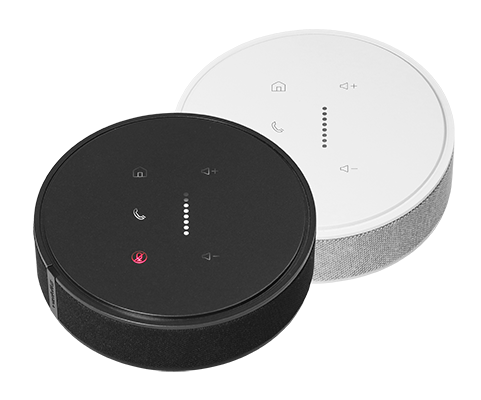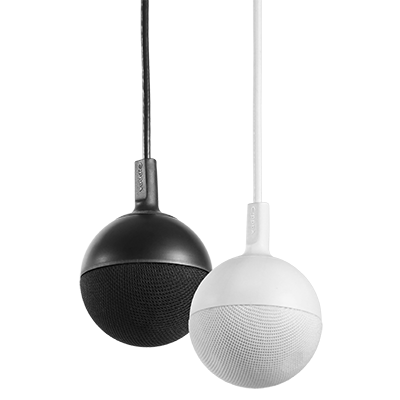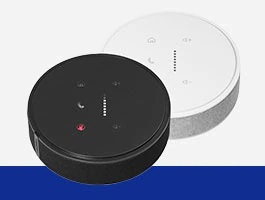Table or Ceiling Microphones: The Basics for Selection
Posted on 7/15/2020 12:00:00 AM by Vaddio Team
When setting up a conference room, attention is rightfully paid to the video equipment, the display and the furniture – tangible items that immediately define the atmosphere of a space.
Equally as important is the audio for the room – specifically the microphones for the meeting participants. The ability to clearly capture voice audio is the hallmark of a productive meeting, and there are few things more distracting than poor sound quality. Sound quality involves more than just capturing voices at an acceptable level. Background or ambient noise – either from non-speaking meeting participants or environmental factors such as air vents – also must be minimized.
When designing a conference room audio system, there are two types of microphones to consider: table mics and ceiling mics. Which one to use depends on several conditions, including the height of the ceiling, the aesthetics of the room, whether there’s a control panel present or not, and whether there are existing audio equipment standards within the same building.
While both table and ceiling mics have their pros and cons, it’s important to weigh all considerations to select the form factor microphone that will work best.
Table Mics: Advantages and Disadvantages
Table mics do have significant advantages, particularly when the mics are set up to provide 360-degree coverage of a conference room. Ideally, three table mics strategically placed on a table make it relatively easy to get 360-degree coverage.
Vaddio’s TableMIC microphone includes a built-in array of three discrete microphones that provide 360-degree voice pickup. With a table mic, the voices of the speakers are amplified due to sound reflected off the table. The same reflection occurs with PZM (pressure zone) microphones, especially if the setup includes a piece of plexiglass. There’s a certain acoustic gain in efficiency if the mic serves to focus like an antenna on the reflections of sound coming off the table surface.

Another advantage: table mics offer convenient placement for control interfaces.The participants in the room can easily access mute buttons, volume controls and level indicators to adjust audio output accordingly. This feature can be particularly useful in BYOD environments; when table mics with standard controls are installed across rooms within a building, the user experience remains the same in all meeting rooms. There’s no learning curve as users move from meeting space to meeting space, simplifying the conferencing experience considerably.
There are a few caveats with table mics. With wired models, the wires run on the table, which isn’t always visually appealing. There could be additional table clutter such as cables for other equipment. A more significant drawback is the potential for ambient noise – people tapping their fingers, shuffling papers, clicking on their mouse, typing on their laptop keyboards – activities that take place near the mic can cause issues with ambient noise.
Ceiling Microphones: Pros and Cons
For pure aesthetics, ceiling mics are often preferred by designers. Many ceiling mics offer streamlined, modern pendant designs that suspend from a ceiling, are unobtrusive and complement the conference room décor. Ceiling mics don’t contribute to table clutter, and there is much less potential for the ambient noise from a table to be picked up by ceiling mics given their location.
However, ceiling mics – due to their placement – have limitations. The sound at the table level is different from the sound at the ceiling. Sound essentially can hang in a room before it dissipates. At the ceiling, the sound of voices can be less clear due to echoes caused by the size of the room and surfaces found in the room. Vaddio’s CeilingMIC overhead microphones include integrated echo cancellation and digital signal processing (DSP) to deliver crisp, clear sound.

Another issue that can crop up with ceiling mics is the presence of other equipment on the ceiling. Projectors with fans and HVAC systems create noise that can be picked up by a nearby ceiling mic.
To get wide coverage of the room, the collection pattern of ceiling mics should overlap in a way that also causes the mics to listen relatively well up toward the ceiling tiles, which in turn accentuates the HVAC and other noise problems – such as radiated noise that travels across the ceiling from other rooms. While there are ways to mitigate these issues, it’s important to acknowledge them when evaluating the use of table mics or ceiling mics. As for volume and mute functions, there are a number of ways to handle these with ceiling mics. For example, ceiling mics can be linked to a control panel that enables adjustments via serial or IP connections.
Download the full eBook to learn more about best practices in audio.




